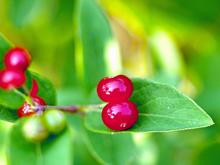Quick facts
The non-native (exotic) Bell's, Morrow's, Tartarian and Amur honeysuckles are Restricted noxious weeds in Minnesota.
Exotic honeysuckles leaf out early in the season and shade out native herbaceous ground cover.
Plants deplete soil moisture and inhibit the growth of other plants and trees in the vicinity.
Northern bush honeysuckle (Diervilla lonicera) is native to Minnesota and a good substitute for local landscapes.
How to identify honeysuckles
- Upright deciduous shrubs, 8–12 feet high.
- Bell's honeysuckle is a larger horticultural hybrid; up to 20 feet.
Stem
- Older stems have shaggy bark and are often hollow.
Leaves
- Opposite, simple, oval and untoothed.
- Morrow's (L. morrowii) has downy leaves.
- Hybrid Bell's (L. x bella) leaves may be hairless or downy.
- Tartarian (L. tatarica) has smooth hairless leaves.
- Amur honeysuckle (L. maackii) leaves come to a long, sharp point.
Flowers
- Fragrant, tubular white, red or, most often, pink flowers.
- Blooms in May and June.
Fruit and seeds
- Fruits are red or yellow, situated in pairs in the leaf axils.
- Birds disperse the seeds easily.
Roots
- Fibrous and shallow.
Reviewed in 2024




